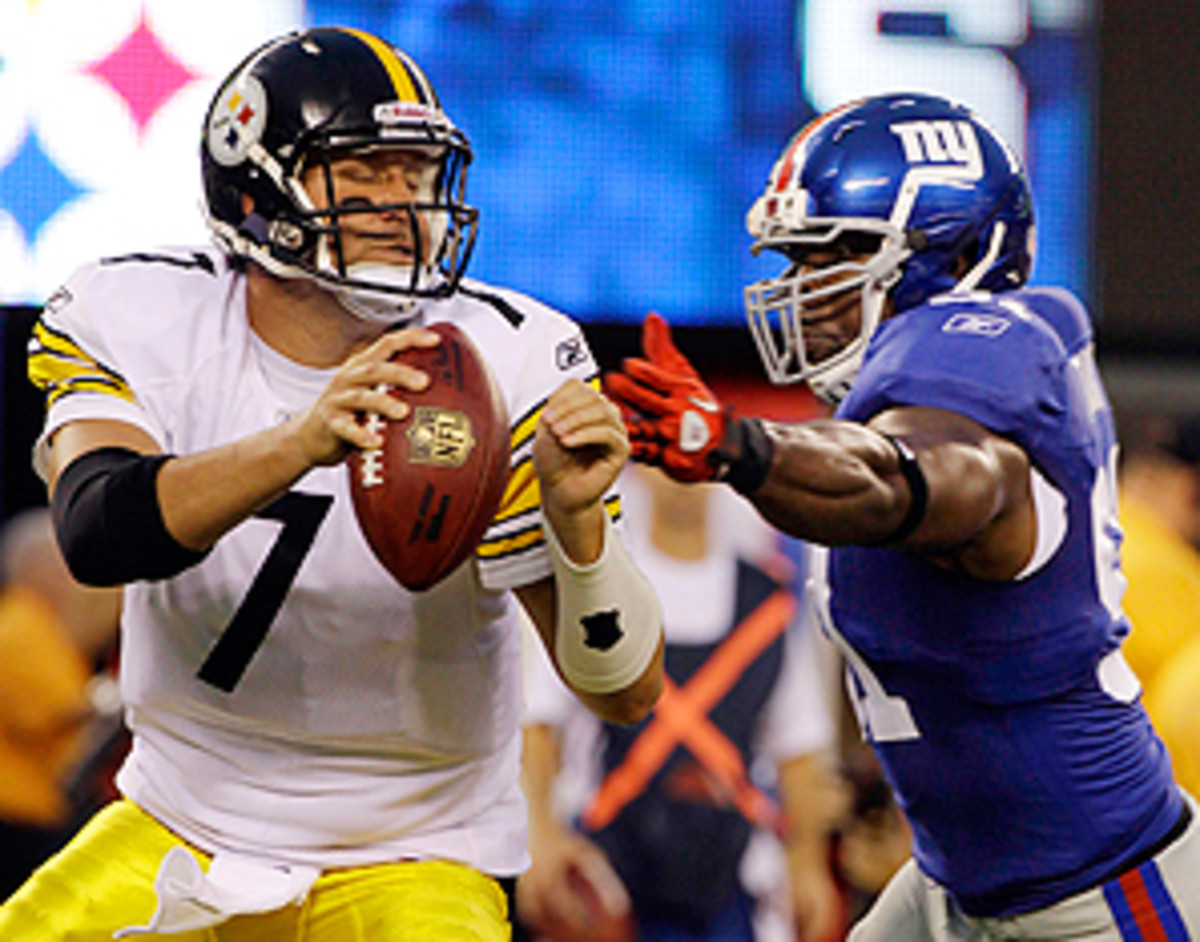Why Super Bowl XLV in Dallas could be a Giants-Steelers matchup
It's merely the midpoint of the 2010 campaign, but if you look through the statistical fog you might make out a Giants-Steelers Super Bowl at the end of the season.
At least if the Cold, Hard Football Facts all-powerful Defensive Hog Index is any indication.
We introduced the Defensive Hog Index before the 2007 season as a way to quantify the relative merits of each NFL team's defensive front. It's had an incredible record of success, especially in the postseason: if you look only at this indicator and nothing else, it's 25-8 picking playoff winners over the past three years.
The Defensive Hog Index measures the performance of each defensive front in three key areas:
• Ability to stop the run (as measured by opponent average per rush attempt)
• Ability to force what we call Negative Pass Plays (as measured by the percentage of opponent drop backs that end in a sack or INT)
• Ability to snuff out drives (as measured by opponent success on third downs)
The Giants are No. 1 across the board on the indicator right now, dominant in all three areas of the DHI. The Steelers are No. 3 across the board, with a shutdown run defense that's on pace to be the most dominant in modern history.
Pittsburgh's opponents generate just 2.61 YPA on the ground. The current Super Bowl Era record for stingy run defense is held by the legendary 2000 Ravens, who held opponents to 2.69 YPA on the ground.
Football historians might be interested to know that the 1976 Steelers, the greatest of the famed Steel Curtain units against the run, allowed opponents an average of 3.22 YPA on the ground.
Both the Giants and Steelers have proud legacies on the short but wildly successful history of the Defensive Hog Index. In fact, they're the closest thing we've seen to Defensive Hog dynasties. It's this history that makes us believe that a Giants-Steelers Super Bowl is a very real possibility.
The Giants topped the DHI in 2007. They won the Super Bowl. The Steelers topped the DHI in 2008. They won the Super Bowl, too. The 2009 Saints were merely mediocre (15th), but they dominated Indy's lowly Defensive Hogs (30th) in the Super Bowl, in yet another victory for the indicator.
Fast forward to 2010, and here's a look at the top of the Defensive Hog Index through Week 8.
While the Giants and Steelers are legit Super Bowl contenders (for many reasons), the No. 2 Chargers remain a rare curiosity in the annals of the NFL. As we discussed here last week, they dominate in almost every major statistical indicator, including the DHI. But they've been unable to turn dominance on the stat sheet into wins on the scoreboard.
The Giants and Steelers suffer no such problem. Both clubs are 5-2 and look like surefire playoff teams.
In the case of the 2010 Giants and Steelers, the most encouraging part is that each defensive front stacks up quite well against their Super Bowl-winning Defensive Hogs of recent history.
Here's how New York's No. 1-ranked Defensive Hogs of 2010 compare to New York's No. 1-ranked Super Bowl-winning Defensive Hogs of 2007 in all the indicators that comprise the indicator.
The numbers are impressive. The 2010 Giants are stingier against the run, more likely to force Negative Pass Plays and better on third down than even their top-ranked Super Bowl-winning unit of 2007.
That's no small feat. Remember, it was those Defensive Hogs who were largely responsible for the greatest statistical upset in NFL history: the 2007 unit beat up Tom Brady and New England's record-setting offense on the way to a 17-14 Super Bowl victory.
Big Blue defensive end Osi Umenyiora, meanwhile, was the primary catalyst for both groups of dominant New York D-Hogs. He's second in the NFL this year with 8.0 sacks. He was fifth in the NFL in 2007, with 13.0 sacks.
Meanwhile, here's how Pittsburgh's third-ranked D-Hogs of 2010 stack up against its Super Bowl-winning unit of 2008.
The 2010 unit is not as impressive at this point. After all, the 2008 Steelers boasted the NFL's best Defensive Hogs in every single component of the indicator.
Those 2008 D-Hogs were truly a great unit: they stopped the run, pressured the quarterback and stifled offenses on third down better than every other defensive front in football that year.
As was the case with the 2007 Giants, Pittsburgh's D-Hogs played a pivotal role in their Super Bowl victory over the Cardinals. Arizona couldn't run the football that day (12 attempts, 33 yards, 2.8 YPA) and struggled on third down, converting just 3 of 7 (37%), not far off the average performance against Pittsburgh in 2008.
Most importantly, it was a member of the defensive hogs that made the biggest play of the game: stud linebacker James Harrison returned an interception 100 yards for a touchdown. The Steelers won 27-23.
Harrison was the NFL's Defensive Player of the Year in 2008, thanks largely to his 16.0 sacks, and is leading the charge in Pittsburgh again here in 2010. He boasts a team-high 6.0 sacks and four forced fumbles.
Besides the potential meeting of the NFL's two modern Defensive Hog dynasties, a Giants-Steelers Super Bowl would offer us a bit of history, too: These marquee franchises and old-school NFL powers -- each in the league more than 75 years -- have never met in the postseason.






